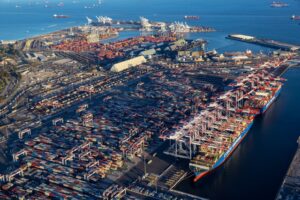Gothenburg Port: Digitalized port calls could reduce CO2 emissions by 6,000 tons
The Port of Gothenburg expects a decrease of 6,000 tons of CO2 emissions in the port area per year thanks to the conditions created by digitalized port calls.

The Port of Gothenburg is the largest port in Scandinavia, handling approximately 6,000 ship calls per year. At each arrival, a multitude of actors in the port are activated, from the moment a vessel enters the port area until it is berthed.
From the departure of a vessel from its previous port, until it arrives at the Port of Gothenburg, large amounts of information need to be communicated between up to 120 different actors who need to be synchronized, including shipping companies, terminals, tugboats, pilots, boatmen, and traffic planner.
“With our Digital Port Call platform, all necessary information can be collected and processed into a common situational awareness that provides data-driven decision support throughout the call process. This provides better predictability and opportunities for more efficient resource planning, while any disruptions can be detected and addressed early,” Fredrik Rauer, Manager Port Control at the Gothenburg Port Authority explained.
The digital platform enables just-in-time arrivals for vessels. By receiving a “digital queue ticket” well in advance of arrival, vessels avoid rushing into the port area for a favorable slot time. Instead, it can adjust to a more eco-friendly speed during the sailing from the previous port so that upon arrival in the Gothenburg port area, it can proceed directly to a pre-assigned quay, the port said.
Inter Terminals is a terminal company in the Port of Gothenburg Energy Port as well as a port call actor providing data to Digital Port Call. The company has also been a collaborating partner in preparation for the platform’s launch.
Related Article
“We always aim to be at the forefront of digitalization that creates value for us and our customers. Digital Port Call enhances the flow of information between actors in the Energy Port and provides opportunities for our customers to reduce their fuel consumption, so it has been natural for us to be involved from the beginning,” stated Thomas Andersson, Manager Logistics Services at Inter Terminals.
When calculating the total reduction in anchorage and berth time, the Port of Gothenburg expects a decrease of 6,000 tons of CO2 emissions in the port area per year thanks to the conditions created by Digital Port Call.
“And these numbers don’t even include the reduction that will occur outside the port area due to slow steaming from the previous port. When we add that other port call actors now are able to use their resources more wisely efficiently in the process, we can conclude that all parties benefit from Digital Port Call,” Gabriella Ståhle, Production Planner in the Energy Port at the Port of Gothenburg commented.
The Digital Port Call is part of the major initiative Green Connection that the Port of Gothenburg is implementing to reduce port-related CO2 emissions by 70% by 2030.
This involves ensuring storage and access to a mix of alternative fuels, as well as investments in physical and digital infrastructure that support a fossil-free logistics chain – at sea, on land, and at the terminals. €60 million ($64.7 million) is earmarked for investments in CO2-reducing measures.
In 2022, the Swedish government selected three Port of Gothenburg projects for a green transformation of shipping to constitute Sweden’s contribution to the international initiative Green Shipping Challenge.
Related Article
-
Port of Gothenburg joining green shipping initiative
Ports & Logistics








